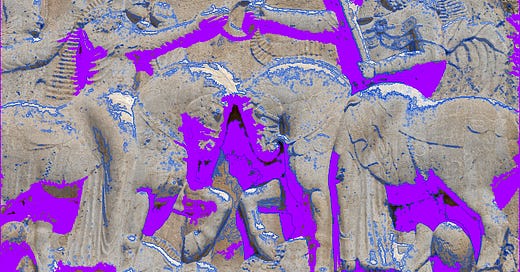Rock relief of Ardashir I receiving the ring of kingship by the Zoroastrian supreme god Ahura Mazda.
Notes on Iran I
At the time of the founding of the Sasanid Empire, in 224, Vindobona, the forerunner to Vienna, had just attained the status of a municipality, counting 15,000 souls, and just over a decade later, in 238, the invasions of tribes such as the Goths, which were eventually to lead to the downfall of the Roman Empire, began.
“At its height in the sixth century” we’re told[1] “the Sasanian Empire extended from the Euphrates to the Indus valley, and it was involved in constant fighting with the Romans and Byzantines on its western flank. The Sasanian imperial capital was at Ctesiphon (Taj-I Khusrau), on the banks of the Tigris, just southeast of the modern city of Baghdad; its official religion, set out in the Avestan scriptures, was a modified form of Zoroastrianism, which saw life as a struggle on the part of the supreme creator (Ahura Mazda), representing life and truth, against the forces of evil and darkness, in which man would finally be judged by the extent of his commitment to one side or the other.”
“Unlike the Umayyad dynasty,” Jim Al-Khalili informs us[2] “whose capital, Damascus, had been part of the Greek-speaking Byzantine Empire, the Abbāsids had moved the whole operation further east into the heart of what had been part of the Persian Empire of the Sasanians. This was no accident. Powerful Persian clans such as the Barmakis and the Nawbakhts had helped them to power and continued to maintain a strong influence in government for many generations. The Abbāsids, in turn, needed the support of this Persian nobility and encouraged the interweaving of Arab and Persian cultures and identities.”
“But Arabic was now the official language of the empire, and there was immediately seen to be a need for translation of Pahlavi texts into Arabic, and full caliphal support was offered to the project. Some of these texts were Persian in origin; others, such as many medical, mathematical and astronomical works, had been originally translated into Pahlavi from Greek and Indian and were in use in cities such as Gondēshāpūr (called Jundaysābūr in Arabic). So the first and most important factor in bringing about the translation movement was this Abbāsid obsession with Persian culture. This was typified by one translator who, when asked why he searched for Persian books to translate into Arabic, is supposed to have replied: ‘we [the Arabs] have all the words, but they “[the Persians] have all the ideas.’”
Just before the period of the Umayyad Caliphate (661-750), it must be remembered, the Slavs had just completed their conquest of the Balkans and shortly after the establishment of the Abbasid dynasty in 750 Pippin III, King of the Franks, founded the Carolingian dynasty. For Europe, this was very much the period of the “Dark Ages”, a time when life was “nasty, brutal and short”.
“Peerless in the seventeenth century,” Justin Marozzi writes, “Isfahan had been a great city long before that. Dating back to pre-Islamic times, in the tenth century it was the stately seat of Iran’s Buyid Dynasty (r.932-1055), which in 945 had seized Baghdad from its indolent Abbasid caliph to usher in a century of heterodox Shia rule in one of Islam’s holiest cities. After this period of Iranian history, often known as the “Iranian intermezzo” between the rule of Abbasid Caliphate and the Seljuq Empire, from 1040-1194 Isfahan served as the capital of the Great Seljuqs, a thrusting Central Asia confederacy of tribes whose empire at its apogee in the closing years of the eleventh century stretched from the Hindu Kush mountains in the east to the Aegean coast in the west.”[3]
In terms of comparison: Vietnam became independent of China in 939, Otto I of Germany defeated the Magyars at Lechfeld in 955, the Sung dynasty reunited China in 979, the Church of the (Kievan) Rus was founded in 988 and the Vikings colonised Greenland and discovered North America (Vinland), in c.1000.
When discussing Iran (and Persia) it’s important to be conscious of the temporal and physical dimensions involved. Israel, by comparison, was created in living memory.
“Until comparatively recently,” we’re told[4], “most Europeans believed that their continent had always been the centre of the civilised world. The thrust of much recent research has largely modified this view and suggests that European pre-eminence does not significantly antedate the scientific revolution (c.1540-c.1680) and its various technological applications in the industrial revolution (c.1770). Hence the ‘new science’ bestowed no technological advantage on say, England, France or the Netherlands, as against China or the Ottoman Empire, before the end of the eighteenth century.”
[1] p.14 Atlas of Islamic History, Peter Sluglett with Andrew Currie
[2] The House of Wisdom, Jim Al-Khalili
[3] p.256 Islamic Empires, Justin Marozzi
[4] p.38 Atlas of Islamic History, Peter Sluglett with Andrew Currie





The context is everything
https://open.substack.com/pub/scnorthstarconservatives/p/from-juniper-oak-to-iran-the-playbook?r=5r0rr7&utm_medium=ios